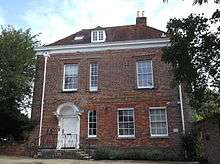Verderer
Verderers are officials in Britain who deal with Common land in certain former royal hunting areas which are the property of The Crown.[1] The office was developed in the Middle Ages to administer Forest Law on behalf of the King. Verderers investigated and recorded minor offences such as the taking of venison and the illegal cutting of woodland, and dealt with the day-to-day forest administration. In the modern era verderers are still to be found in the New Forest, the Forest of Dean, and Epping Forest, where they serve to protect commoning practices, and conserve the traditional landscape and wildlife.
Origins
Verderers[2] were originally part of the ancient judicial and administrative hierarchy of the vast areas of English forests and Royal Forests set aside by William the Conqueror for hunting. The title Verderer comes from the Norman word ‘vert’ meaning green and referring to woodland. These forests were divided into provinces each having a Chief Justice who travelled around on circuit dealing with the more serious offences. Verderers investigated and recorded minor offences and dealt with the day to day forest administration.
New Forest Verderers

The New Forest Verderers [3] still hold their courts at the Verderers’ Hall in Lyndhurst, Hampshire built around the manor house of the Royal Manor of Lyndhurst in 1388 now known as Queen’s House.
Major changes from the ancient system took place with the passing of the New Forest Act 1877, also known as the Commoners’ Charter. This increased the number of Verderers. The Official Verderer was appointed by the Crown and the others were elected locally by registered commoners living within the New Forest. The Verderers themselves each had to own more than 75 acres in the New Forest with common rights attached. They were expected to control the grazing and health of the animals turned out on the Forest, to make bylaws and regulate rights of common. The reorganised Court of Swainmote was given the status of Petty Sessions and the Verderers powers of a Justice of the Peace.
The New Forest Act 1949 reconstituted the Court of Swainmote. A register of voters was kept by the Verderers and a secret ballot imposed to elect 5 Verderers who join 4 who were nominated by the Forestry Commission, Ministry of Agriculture (now DEFRA), Hampshire County Council and the Countryside Agency, together with the appointed Official Verderer. The Court's powers were strengthened, and fencing of roads began and cattle grids introduced. The Verderers could also grant the Forestry Commission new inclosures for timber production. Agisters carry out the day-to-day work with the animals on behalf of the court.
Today the New Forest is a National Park, run by an independent organisation operating in a local government framework and funded by central government. The Verderers have a new statutory duty to take account of the purposes of National Park designation when making any decision which affects the Park (under section 62 of the Environment Act 1995). The Secretary of State issued guidance to the National Park Authority which emphasises strongly the need for the Authority to develop good working relationships with existing statutory bodies and, in particular, with the Forestry Commission, the Verderers and the Lymington Harbour Commissioners.
The New Forest Verderers still sit in open court most months and members of the public may address them on matters pertaining to the New Forest.
Forest of Dean Verderers

The Verderers in the Forest of Dean have been in existence since at least 1218 and are charged with protecting the vert and venison (that is, generally, the vegetation and habitat[4]) of the Forest. They are the last remnant of the traditional forest administration – unlike the New Forest, their structure has been unaltered over the centuries – there are still four verderers just as there has been for the past 800 years. The Verderers are elected by the freeholders of Gloucestershire at the Gloucester Court (an ancient procedure in its own right) and serve for life. Over the years, the deer in the Forest of Dean have fluctuated in numbers and species (they were totally absent for about 90 years from 1855) but today a herd of about 400 fallow deer inhabits the Forest. The Verderers now meet quarterly in their courtroom in the Speech House, close to the centre of the Forest.
Epping Forest Verderers
Verderers in the former Royal Forest of Epping (formerly Waltham Forest) have been appointed since the early 13th century, although early records are incomplete. The office was preserved by the Epping Forest Act 1878, which named the foundation verderers of the new regime—Sir Thomas Fowell Buxton 3rd baronet, Sir Antonio Brady, Thomas Charles Baring, and Andrew Johnston. They are nowadays elected at septennial elections among the registered commoners, two for the northern parishes, two for the southern. The verderers act as representatives of the users of the Forest, meet the Superintendent and other officials regularly, and are members of the Epping Forest Committee of the City of London. The history of the verderers of this Forest has been meticulously researched.[5]
See also
References
- ↑ http://www.verderers.org.uk/
- ↑ 1970s Forestry Commission publication Explore the New Forest article by Oliver Crosthwaite-Eyre
- ↑ 1970s Forestry Commission publication Explore the New Forest article by Oliver Crosthwaite-Eyre
- ↑ "Glossary". Verderers of the Forest of Dean. Verderers of the Forest of Dean. 2009. Retrieved 2009-04-25.
- ↑ Morris, Richard (2004). Verderers and Courts of Waltham Forest in the County of Essex, 1250-2000. Loughton and District Historical Society. ISBN 0954231465.